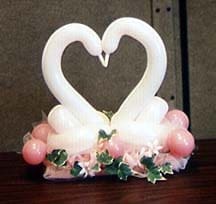
This is a simple, elegant and fast wedding centerpiece which features 260 swans as its focal point. The centerpiece shown uses accents of tulle, silk ivy and small flowers and underinflated 5″ balloons. You can use you can use any accents you desire.
This centerpiece received second place at the 1st annual New England Qualatex Balloon Network Centerpiece competition in July 1996.
Inflate a260’s leaving about 2 inches uninflated on the end . Make a large fold twist (about 6 inches) and twist the knot of the balloon into the fold twist to hide it. Make a second fold twist about the same size or just slightly larger. You should have 8 – 10 inches of balloon left this will become the neck of the swan. Take one loop and push it halfway through the second, this becomes the body with the inside loop pointing upward and becoming the tailfeather. Next you will take the leftover balloon and gently curve the neck by rolling and pinching it (similar to shaping a heart) until it holds the curve. Tuck the base of the swan’s neck into the body so that it sits upright and the outer loop will hold the neck in place. (it will sit on top of the loop of the tailfeather). Create a second swan and cool glue swans facing each other onto the base of the centerpiece. You may now add whatever accent elements you desire.
Check out Marvin Hardy’s Balloon Magic page 26 for the single swan
(for the more experienced twister – Swans are joined at the base of the neck)
To make two swans kissing, follow the directions above until just before you curve and tuck the swan’s necks.
Then you twist everything together at the base of the Swans’ necks and continue as if you were doing two separate swans. Then push the base of the necks (where they meet the bodys) into the folds of the bodies so that the body holds the neck in place, the same as above (you may want to try a single swan firstfor practice). Then you will put the swans beak to beak and the pressure will hold them together. If you are doing the swans for a more lasting creation, a drop of glue between the beaks helps too. If done well (with practice of course) you can get the necks of the swans to form a heart shape.